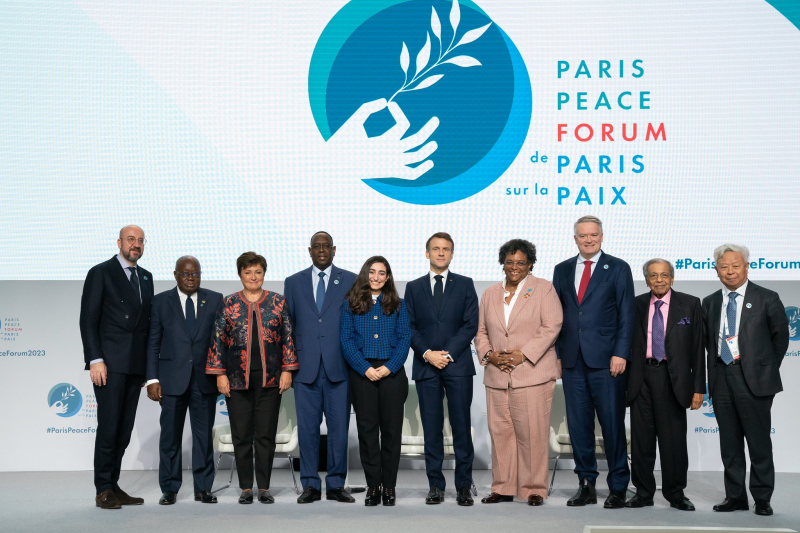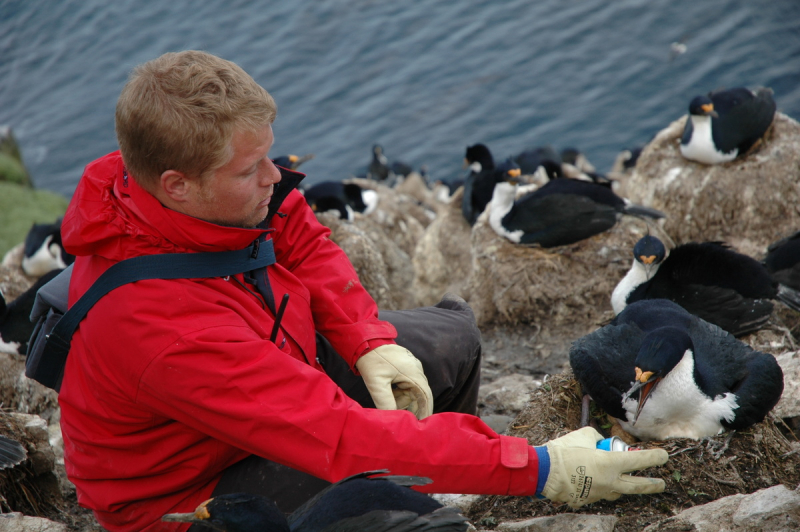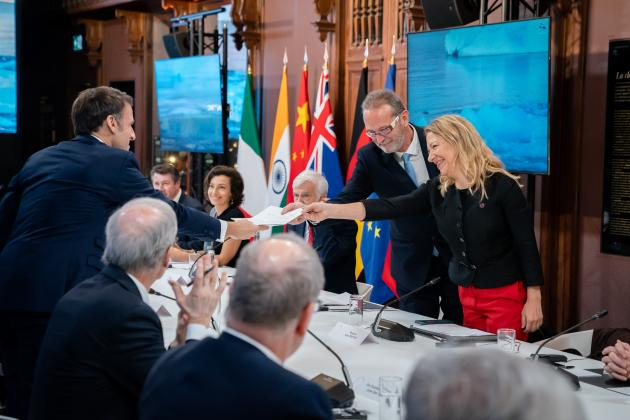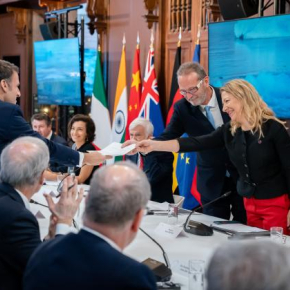
Understanding the poles and glaciers to help protect them better
At the One Planet Polar Summit held in Paris from November 8th to 10th scientists, diplomats and politicians discussed ways of finding out more about the poles and glaciers to preserve them more effectively. The CNRS actively and fully participates in this field of research.
"The cryosphere is like the sentinel or the canary in the coal mine of the climate and biodiversity crises" said Antje Boetius, co-chair of the scientific committee of the One Planet Polar Summit in conclusion to this event. This first international summit devoted to the poles and glaciers followed on from 2022's One Ocean Summit (French link) and had been called for by Emmanuel Macron, the French President. Scientists from 35 countries around the world worked for two days at the French National Natural History Museum before achieving a consensus on the threats to the cryosphere caused by global change (French link). On the third and final day, the political representatives present formulated this consensus in a Paris Call for Poles and Glaciers. It clearly concludes that to protect the cryosphere we initially need to know more about it and that this requires research to be maintained with increased funding (French link).
Local problems that have global consequences
But what exactly does this cryosphere1 represent (French link) ? The cryosphere has a considerable influence on the global climate even though it only covers 10% of the planet's surface. This is firstly the case because it represents three quarters of the Earth's freshwater (French link) with a billion people depending on water from melting snow and glaciers. The second reason for its importance is because snow - and ice to a lesser extent - have a significant albedo2 effect insofar as these white surfaces reflect a large proportion of the sun's rays. Consequently, as stated in the Paris Appeal officially launched by Emmanuel Macron on November 10th, ice-covered areas which "are home to Indigenous Peoples, populations and unique ecosystems, are among the areas most affected by the climate crisis, with implications for the rest of the planet". These implications include rising sea levels, the thawing of permafrost (French link) leading to the release of bacteria buried millions of years ago, natural disasters in mountainous regions and so forth. LaToya Cantrell, the mayor of New Orleans, explains that "if nothing is done to counter the rising waters, New Orleans will become a coastal city within fifty years" even though it is currently located around a hundred kilometres from the Atlantic Ocean.
The summit's objective was to renew and strengthen international collaboration on the cryosphere. Russia is considered particularly important in this context as it is home to half of the Earth's permafrost but international relations have been (metaphorically) frozen since Russia invaded Ukraine in 2022. Another aim was to diversify the stakeholders involved. Along with the polar countries and the countries that have long been involved in study of these regions, high-altitude countries like Nepal (French link) and Peru were also invited, as were countries under serious threat from rising sea levels like India. The Paris Call posits the inclusion of local communities and indigenous peoples in the production of knowledge and also for the reduction of the environmental footprint (French link) of research in these threatened regions. To sum up, as Antje Boetius and Jérôme Chapellaz (French link), CNRS research professor and co-chairman of the scientific committee, agree, "cryospheric sciences requires global governance" because the issues at stake go far beyond the ice-covered areas alone.
Indeed, the Call envisages global solutions to provide long-term protection for the cryosphere and has already been signed by around thirty countries. Such solutions include respecting the Paris Agreements (French link) and thus keeping the temperature increase below 1.5°C as compared with the pre-industrial era; protecting 30% of the world's terrestrial, inland water, marine and coastal areas by 2030; restoring 30% of degraded terrestrial and inland water, marine and coastal ecosystems as set out in the 2022 Kunming-Montreal Global Biodiversity Framework (French link) ; and restricting tourism's impact on glacial and polar regions.
- 1The cryosphere is made up of the regions of the Earth's surface in which water is in a solid state - the immense ice sheets of Antarctica and Greenland, sea ice in the Arctic and Southern Ocean, the snow cover, mountain glaciers and permafrost.
- 2Albedo is the capacity of a surface to reflect solar energy.

How research and public policy can function together
France organised this summit mainly because of the strength of its polar research, in which the CNRS of course plays a leading role. France is ranked among the top ten nations for the number of publications on the Arctic and Antarctic and between 70 and 80% of these involve CNRS scientists. The CNRS is a major stakeholder in polar research (see box) and its work involves (French link) all areas of study of the Earth system - from climate and environmental sciences, ecology and biology to the humanities and social sciences. The CNRS develops autonomous instrumentation, coordinates or takes part in major oceanographic campaigns and also contributes to long-term monitoring as provided by mooring networks in the Arctic Ocean or via the Antarctic and Southern Ocean Territories Workshop Zone.
The CNRS - a major player in research into poles and ice-covered environments
The involvement of CNRS staff and units (see key figures) is complemented by the organisation's role as a major shareholder in the French Polar Institute Paul-Émile Victor. The CNRS also contributes to global scientific collaboration initiatives on the poles by promoting major polar research issues within European (European Polar Board) and international organisations (the International Arctic Science Committee or the Scientific Committee on Antarctic Research). The organisation also participates in institutional facilities in other countries like the Nunavik International Men-Media Observatory and the Takuvik international research laboratory (French link) which are both located in Quebec.
Philippe Hoest observes the CNRS's presence as regards research at the poles every day. This CNRS biosafety research engineer who is currently on secondment was appointed head of the Kerguelen district (French link) in August 2023. He notes that his host institution is involved in the majority of the twenty or so scientific programmes that are run on the archipelago during the austral summer which runs from November to February. The CNRS's interdisciplinary nature means it can cover a "vast scientific spectrum" spanning oceanography, ecology, ornithology, microbiology, atmospheric sciences and geology. The district's head Philippe Hoest hosts all these scientific teams at the Port-aux-Français base and does his utmost to "provide them with the best possible working conditions in the isolated environment" of this sub-polar region.
In the framework of France's National Polar Strategy until 2030 (French link) published last year, the President has announced several important measures: the doubling of France's polar research budget to €1 billion by 2030; the construction of a new French ice-capacity vessel, the Michel Rocard, which will sail the West Pacific and East Antarctic zones; the reconstruction of the Dumont-d'Urville station on the Antarctic Peninsula to begin in 2026 and the subsequent renovation of the Franco-Italian Concordia station.
French research into the cryosphere needs to be consolidated in this way and also more effectively linked to public policy. Françoise Gaill, a marine biologist and head of the International Panel for Ocean Sustainability, explains that this is because the situation "no longer just requires us to understand the causes [of this disruption], we now need to anticipate the consequences". This is precisely the stated aim of the Alliance des Villes et des Régions Côtières (Alliance of Coastal Cities and Regions) which follows on from the previous Sea'Ties initiative. This alliance promotes and encourages the sharing of knowledge, cooperation between local authorities and driving funding to facilitate the development of public policies and the implementation of adaptive solutions for coastal towns and regions facing issues linked to rising sea levels. The stakes are high as by 2050 nearly a billion people living in these areas will face increased risks caused by this phenomenon.

Kerguelen - an open-air laboratory
Kerguelen is the main district of the French Southern and Antarctic Lands and hosts the most scientific activities in both summer and winter. Philippe Hoest explains that this is because the archipelago is like an "open-air laboratory… one of the last places in the world with massive populations of wild animals" - primarily birds and mammals.
Kerguelen's wild dimension stems from the archipelago's geographical position - 3000 km from Réunion Island, the nearest inhabited zone – and "very far from any human activity likely to interfere with scientific results". Its isolated location also makes it a good observatory of man-made global change. The head of the district for explains that Kerguelen gives us a good idea of "the global impact of human activity which is very minimal on the site".
Following the One Planet Polar Summit, all eyes are now on the third United Nations Ocean Conference to be jointly organised in Nice by France and Costa Rica in June 2025. The crucial importance of the melting cryosphere makes it so much more than a metaphorical drop in the ocean.
Au terme du One Planet Polar Summit, les regards se tournent vers Nice, qui accueillera en juin 2025 la troisième Conférence des Nations Unies sur l'Océan, organisée conjointement par la France et le Costa Rica. Car la fonte de la cryosphère risque de peser plus lourd qu’une goutte d’eau dans le vase qu’est l’océan.

A new foundation dedicated to the cryosphere under the auspices of the CNRS
At a parallel event during the One Planet Polar Summit on November 8th, the Swedish businessman Frederik Paulsen, the head of Ferring Pharmaceuticals and a member of the New York Explorers Club, officially launched the Albédo Foundation for the Cryosphere. This new foundation was founded under the auspices of the CNRS Foundation.
The Albédo Foundation has initial funding of 10 million euros and its stated mission is "to provide financial support for interesting national and international French and French-speaking scientific programmes on the cryosphere and particularly on the North and South Polar Regions or very high altitude zones". The Foundation also aims to "mobilise all parts of society which means engaging and motivating them to take an active part in the Foundation's cause".
This new foundation under the auspices of the CNRS joins three others dedicated to the oceans:
- The 1 Ocean Foundation's mission is to support "1 Ocean, the major witness to the Ocean", an exploration project jointly run with UNESCO to mark the United Nations Ocean Decade (2021-2030).
- The Ocean Sustainability Foundation led by the marine biologist Françoise Gaill supports actions to protect marine and ocean environments, particularly the IPOS initiative.
- The Science4Reefs Foundation's mission is to support research into coral reefs and encourage interaction between the scientists concerned and political, industrial, social and cultural stakeholders.


